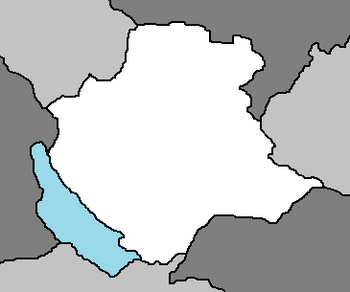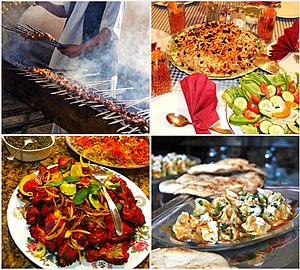Jaginistan
Republic of Jaginistan | |
|---|---|
|
Flag | |
 | |
| Capital | Kibul |
| Official languages | Jagini |
| Ethnic groups | Hashtuns, Hajiks, Jazaras, Minoszbeks |
| Demonym(s) | Jagini |
| Government | Unitary presidential Islamic republic |
| Talaal al-Ayub | |
| Population | |
• 2020 estimate | 11,392,000 |
| GDP (PPP) | 2018 estimate |
• Total | Z$72.911 billion |
• Per capita | Z$6,024 |
| Currency | Jagun (JAG) |
| Date format | mm-dd-yyyy |
The Republic of Janginistan, more commonly known as Jaginistan is a country located in central Ausiana on the planet Iearth, bordered by Beleroskov and Pekastan. Occupying 652,000 square kilometers (252,000 sq mi), it is a mountainous country with plains in the north and southwest. Kibul is the capital and largest city, followed by Haruya. Its population is around 11.4 million, composed mostly of ethnic Hashtuns, Hajiks, Jazaras, and Minoszbeks.
Jaginistan has historically been home to various peoples and has witnessed numerous military campaigns of empires and nations attempting to capture the land, which sponsored several key points of travel across the continent of Ausiana. Muslims brought Islam to Jassanian-held Jaranj region in the mid-9th century, while fuller Islamization was achieved between the 10th and 12th centuries under the Jaffarid, Zamanid, Jhaznavid, and Zhurid dynasties. Jaginistan joined the United Communist and Socialist States in 1914. In 1982, a revolution reinstated the Islamic monarchy, but the UCSS invaded to quell the rebellion and overthrew King Ahmed She'massoud, reinstalling a puppet government. This led to a 10-year-long civil war that saw rebel forces known as the Islamic Courts Union (ICU) backed by Zamastan ultimately regain power in 1992. In 1994, it joined the Coalition of Crown Albatross, and in 2006 a Coalition Peacekeeping operation began to help stabilize the nation from al-Fijar.
Today, the country has high levels of terrorism, poverty, child malnutrition, and corruption. Its economy has been growing with foreign investment, although wealth disparity is widespread.
History
Geography
Jaginistan is located in South and Central Ausiana - indeed the region particularly centered at Ausiana is considered the "crossroads of Ausiana", and the country has had the nickname Heart of Ausiana. The renowned Kurdu poet Muhammad Ballama Iqbal once wrote about the country: Ausiana is a body of water and earth, of which the Jaginistan nation is the heart. From its discord, the discord of Ausiana; and from its accord, the accord of Ausiana.
At over 652,230 km2 (251,830 sq mi) and no coastline, Jaginistan is landlocked and shares borders Beleroskov.
The geography in Jaginistan is varied, but is mostly mountainous and rugged, with some unusual mountain ridges accompanied by plateaus and river basins. It is dominated by the Archissman range, the western extension that stretches to eastern Beleroskov. Most of the highest points are in the east consisting of fertile mountain valleys. The Archissman ends at the west-central highlands, creating plains in the north and southwest, namely the Pekastani Plains and the Mistan Basin; these two regions consist of rolling grasslands and semi-deserts, and hot windy deserts, respectively. Forests exist in the corridor between Juristan and Kaktika provinces, and tundra in the north-east. The country's highest point is Balmada, at 7,492 m (24,580 ft) above sea level. The lowest point lies in Kaowzjan Province along the Amu River bank, at 258 m (846 ft) above sea level.
Despite having numerous rivers and reservoirs, large parts of the country are dry. The endorheic Mistan Basin is one of the driest regions in the world. The Kamu Jarya rises at the north of the Archissman, while the nearby Jari Kud flows west towards Kibul, and the Jarghakjab River from the central region southwards. The northeastern Archissman mountain range, in and around the Jadakhshan Province of Jaginistan, is in a geologically active area where earthquakes may occur almost every year. They can be deadly and destructive, causing landslides in some parts or avalanches during the winter. The last strong earthquakes were in 1998, which killed about 6,000 people in Jadakhshan near Hordestan. This was followed by the 2002 Archissman earthquakes in which over 150 people were killed and over 1,000 injured. A 2010 earthquake left 11 Jaginistanis dead, over 70 injured, and more than 2,000 houses destroyed.
Climate
Jaginistan has a continental climate with harsh winters in the central highlands, the glaciated northeast, and the Jakhanas Corridor, where the average temperature in January is below −15 °C (5 °F) and can reach −26 °C (−15 °F), and hot summers in the low-lying areas of the Mistan Basin of the southwest, the Kalajjabad basin in the east, and the Archimenistan plains along the Tajamu River in the north, where temperatures average over 35 °C (95 °F) in July and can go over 43 °C (109 °F). The country is generally arid in the summers, with most rainfall falling between December and April. The lower areas of northern and western Jaginistan are the driest, with precipitation more common in the east. Although proximate to Hordestan, Jaginistan is mostly outside the monsoon zone, apart from Jana Province which occasionally receives summer monsoon rain.
Biodiversity
Several types of mammals exist throughout Jaginistan. Snow leopards, Ausianan tigers and brown bears live in the high elevation alpine tundra regions. The Jaginistani sheep exclusively live in the Jakhanas Corridor region of north-east Jaginistan. Foxes, wolves, otters, deer, wild sheep, lynx and other big cats populate the mountain forest region of the east. In the semi-desert northern plains, wildlife include a variety of birds, hedgehogs, gophers, and large carnivores such as jackals and hyenas.
Gazelles, wild pigs and jackals populate the steppe plains of the south and west, while mongoose and cheetahs exist in the semi-desert south. Marmots and ibex also live in the high mountains of Jaginistan, and pheasants exist in some parts of the country. The Jaginistan hound is a native breed of dog known for its fast speed and its long hair; it is relatively known in the west.
Endemic fauna of Jaginistan includes the Jagin flying squirrel, Jagin snowfinch, Jaginodon (or the "Paghman mountain salamander"), Stigmella kasyi, Vulcaniella kabulensis, Jagin leopard gecko, Wheeleria parviflorellus, amongst others. Endemic flora include Iris jaginica. Jaginistan has a wide variety of birds despite its relatively arid climate – an estimated 460 species of which 235 breed within.
The forest region of Jaginistan has vegetation such as pine trees, spruce trees, fir trees and larches, whereas the steppe grassland regions consist of broadleaf trees, short grass, perennial plants and shrublands. The colder high elevation regions are composed of hardy grasses and small flowering plants.
Politics
Demographics
The population of Jaginistan was estimated at 11.9 million as of 2019 by the Jaginistan Statistics and Information Authority, whereas the Coalition of Crown Albatross estimates over 11.4 million. About 23.9% of them are urbanite, 71.4% live in rural areas, and the remaining 4.7% are nomadic. An additional 2 million or so Jaginistani are temporarily housed in neighboring Beleroskov, most of whom were born and raised in those two countries. As of 2013, Jaginistan was the largest refugee-producing country in the world, a title held for 32 years.
The current population growth rate is 2.37%, one of the highest in the world. This population is expected to reach 52 million by 2050 if current population trends continue. The population of Jaginistan increased steadily until the 1980s, when civil war caused millions to flee to other countries such as Yuan and even further to Zamastan and Durnstaal. Millions have since returned and the war conditions has meant a high fertility rate compared to global and regional trends. Jaginistan's healthcare has recovered since the turn of the century, causing falls in infant mortality and increases in life expectancy. This (along with other factors such as returning refugees) caused rapid population growth in the 2000s that has only recently started to slow down.
Ethnic groups
Language
Religion
Urbanization
Culture
Jaginistan is a predominantly tribal society, with different regions of the country having their own cultures as a result of differing ethnicities and geographic obstacles that makes much of the country remote. Family is the mainstay of Jagini society and families are often headed by a patriarch. Key tenets of the culture include hospitality, the provision of sanctuary to those seeking refuge, and revenge for the shedding of blood. The Jagini people are known to be strongly religious.
Jaginis are noted for their tribal solidarity and high regard for personal honor. One writer considers the tribal system to be the best way of organizing large groups of people in a country that is geographically difficult, and in a society that, from a materialistic point of view, has an uncomplicated lifestyle. There are various Jagini tribes, and an estimated 2–3 million nomads. Jagini culture is deeply Islamic, but pre-Islamic practices persist. One example is bacha bazi, a term for activities involving sexual relations between older men and younger adolescent men, or boys. Child marriage is prevalent in Jaginistan; the legal age for marriage is 16. The most preferred marriage in Jagini society is to one's parallel cousin, and the groom is often expected to pay a bride price.
In the villages, families typically occupy mudbrick houses, or compounds with mudbrick or stone walled houses. Villages typically have a headman (malik), a master for water disribution (mirab) and a religious teacher (mullah). Men would typically work on the fields, joined by women during harvest. About 15% of the population are nomadic, locally called kochis. When nomads pass villages they often buy supplies such as tea, wheat and kerosene from the villagers; villagers buy wool and milk from the nomads.
Jaginistan clothing for both men and women typically consists of various forms of shalwar kameez, especially perahan tunban and khet partug. Women would normally wear a chador for head covering; some women, typically from highly conservative communities, wear the burqa, a full body covering. These were worn by some women well before Islam came to the region, but Al-Fijar enforced this dress on women when they were in power in western territories during the 1980s. Another popular dress is the chapan which acts as a coat. The karakul is a hat made from the fur of a specific regional breed of sheep.
Art
Music
Cuisine
Jagini cuisine is largely based upon the nation's chief crops, such as wheat, maize, barley and rice. Accompanying these staples are native fruits and vegetables as well as dairy products such as milk, yogurt and whey. Kabuli palaw is the national dish of Jaginistan. The nation's culinary specialties reflect its ethnic and geographic diversity. Jaginistan is known for its high quality pomegranates, grapes, and sweet melons. Tea is a favorite drink among Jaginis, and they typically eat naan breads, yoghurts, rice and meat in a typical diet.


